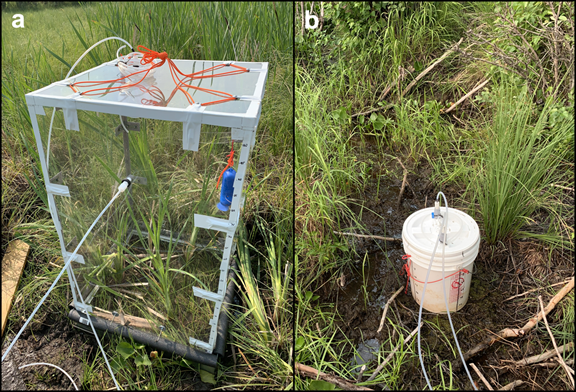The ORNL DAAC recently released a new Arctic-Boreal Vulnerability Experiment (ABoVE) dataset by Elder, C., et al. (2021):
Methane Fluxes from Shorelines and Differing Surfaces, Big Trail Lake, Alaska, 2019
This dataset provides methane fluxes from hot-spot and non-hot spot differing surfaces at Big Trail Lake (BTL) in the Goldstream Valley near Fairbanks, AK, USA. Measurements were taken at a remotely-sensed methane hotspot on the shoreline of a pond, adjacent to BTL with a Los Gatos Ultra-Portable Greenhouse Gas Analyzer (UGGA), and from various non-hotspot surfaces representative of the broader thermokarst lake ecosystem with bucket chambers. All data were collected between 2019-07-04 and 2019-12-04 during the daytime hours of 09:35-17:32 local time. A ground-based CH4 enhancement survey was performed on 2019-07-06 between 13:25-17:15 Alaska Daylight Time (AKDT), approximately two hours following an AVIRIS-NG overflight and hotspot detection at the Eastside Pond. Methane flux is reported in units of both mmol CH4 m-2 hr-1 and mg CH4 m-2 d-1. Flux errors are quantified for each
The ABoVE is a NASA Terrestrial Ecology Program field campaign being conducted in Alaska and western Canada, for 8 to 10 years, starting in 2015. Research for ABoVE links field-based, process-level studies with geospatial data products derived from airborne and satellite sensors, providing a foundation for improving the analysis, and modeling capabilities needed to understand and predict ecosystem responses to, and societal implications of, climate change in the Arctic and Boreal regions.
Additional data from ABoVE and other relevant links can be found on the ORNL DAAC's ABoVE Project Page.
Citation: Elder, C., N. Hasson, P. Hanke, S. Wright, K.W. Anthony, and C.E. Miller. 2021. Methane Fluxes from Shorelines and Differing Surfaces, Big Trail Lake, Alaska, 2019. ORNL DAAC, Oak Ridge, Tennessee, USA. https://doi.org/10.3334/ORNLDAAC/1870

